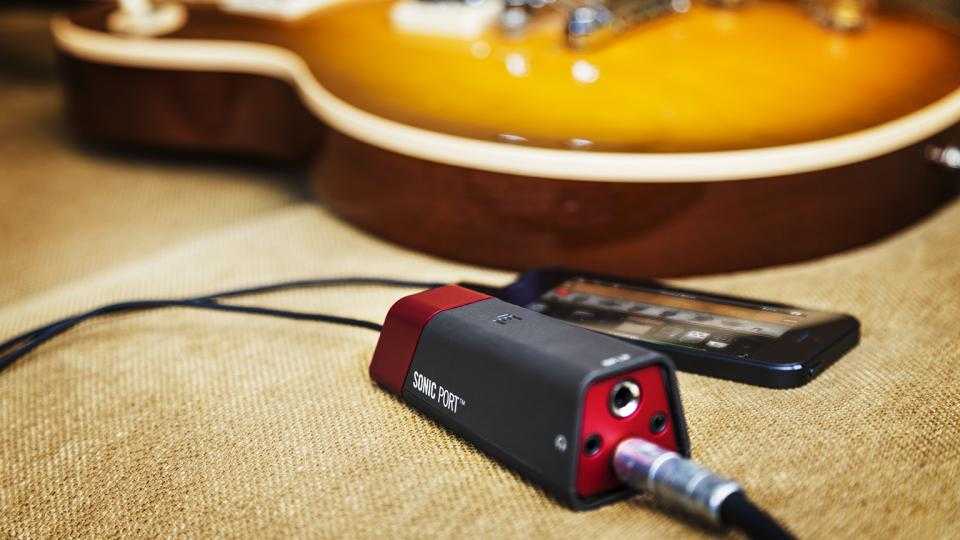Computers are an intrinsic part of modern music production, but there's something slightly depressing about being hunched over your computer when playing an instrument. If you're an electric guitarist, you'll want to kick back, turn up the volume and see the valves in your amp glowing. Your neighbours might have other ideas, of course.
An iPhone, iPod touch or iPad can make the perfect practice amp. You can take it anywhere, plug in a guitar and headphones and be playing in a matter of seconds. If you want to play with other people, just plug your phone or tablet into rehearsal studio speakers or even a hi-fi. It's much less hassle than carting a guitar amp and lots of effects pedals around. Best of all, you're not limited to the sound of a single amp. The apps we cover this month can simulate a wide range of amps, speaker cabinets and effects for every conceivable guitar sound - all for about £15.
Plug it in
The app isn't the only purchase you'll need to make, though. iPhones don't come with quarter-inch jack sockets, so you'll need some kind of adaptor to get your guitar signal into the device.
The cheapest kind are simple adaptors that don't require a power supply and pipe the guitar signal in through the iOS device's microphone input. The microphone input and headphone output is on a combined socket, so these adaptors also provide a duplicate headphone socket. The IK Multimedia iRig was the first of this kind of adaptor, and it's still available for around £20. An updated iRig 2 has just been announced, which is expected to cost £30. It adds an input volume control and a quarter-inch jack output for connecting to a conventional amplifier. The cheapest example of this kind of adaptor that we've spotted is the Peavey AmpKit LiNK II, which is £10 from www.gear4music.com .
^ The iRig 2 is a low-cost way to get a guitar signal into your iOS device via the combination headphone/microphone socket
These interfaces get the job done, but it's fair to say that iOS microphone inputs aren't designed for guitars. There's a lot of noise, especially when distortion and compression effects are applied. There's also a risk of feedback even when the connected guitar's volume is turned down, due to crosstalk between the microphone and headphone signals. The guitar amp apps do their best to tackle these problems using noise gates and feedback suppression algorithms. Overall, we'd say that these adaptors work well enough for private practice, but if you like lots of distortion and particularly if you might be playing to an audience with your iOS device, it's best to go for something more capable.
Dock of the Bay
The next step up is an audio input that connects to the iOS device's 30-pin or Lightning connector. These are essentially USB audio interfaces, with all the analogue circuitry and analogue-to-digital conversion taking place within the controlled confines of the interface. There are various interfaces specifically designed for electric guitars, such as the Line 6 Sonic Port (around £69), Pocketlabworks iRiffPort (£69), IK Multimedia iRig HD (£69) and Apogee JAM (£85).
^ You can get higher quality audio with devices that connect to the iOS dock port, such as this Line 6 Sonic Port
The iRig HD and Apogee JAM both have a single guitar input, which means the iOS device's headphone socket is still used as the output. That's not much of a hindrance for use with headphones, as the quality of iOS headphone outputs is pretty good. However, minijack sockets are quite fragile, so we wouldn't want to use it in a gig. Both of these interfaces come with 30-pin, Lightning and standard Type A USB cables, so they'll work with any generation of iOS device, and Windows and Mac computers too.
The iRiffPort has its own headphone socket and line output, both on minijack sockets. However, it's worth noting that this adaptor is only available with the older 30-pin iOS connector.
The Line 6 Sonic Port is the best specified, with a quarter-inch socket for the guitar input and another serving as a line output to feed a guitar amp or PA system. There's also an aux input and headphone output on stereo minijacks. The lack of an input volume control seems like a bit of an oversight, but it's usually possible to turn down on the guitar to avoid overloading the input. Line 6 also throws in the Mobile POD app. The Sonic Port comes with both 30-pin and Lightning cables, but confusingly it only supports iOS devices dating back to the 4th generation iPad and iPhone 5, all of which use Lightning connectors.
^ Line 6 Mobile Port is our favourite for sound quality, with a rich vibrancy to its amps and effects
Another option is to invest in something that can accommodate more than just electric guitars. We used the iRig Pro (£105), which adds an XLR microphone input with phantom power for studio microphones. It also has a MIDI input, although it's worth noting that this is the old-fashioned 5-pin DIN connector rather than the standard USB cable that most modern MIDI keyboards use. Another option is the Line 6 Sonic Port VX (£135), which incorporates a stereo microphone and a stereo line output on dual quarter-inch jack sockets.
^ The Alesis iO Dock II has inputs and outputs for every occasion, plus a bit of protection for the iPad
The only downside with these interfaces is that, because they're powered by the dock connector, the iOS device can't be charged at the same time. To get around this, consider the Alesis iO Dock II (£129), which is mains powered and includes a comprehensive set of inputs and outputs. It's designed to hold an iPad securely and is probably the best option if you're planning to take your app-powered guitar on the road.

